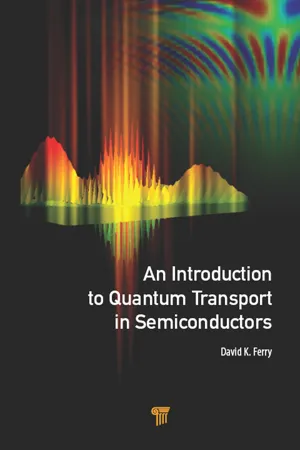
- 526 pages
- English
- ePUB (mobile friendly)
- Available on iOS & Android
An Introduction to Quantum Transport in Semiconductors
About this book
Throughout their college career, most engineering students have done problems and studies that are basically situated in the classical world. Some may have taken quantum mechanics as their chosen field of study. This book moves beyond the basics to highlight the full quantum mechanical nature of the transport of carriers through nanoelectronic structures. The book is unique in that addresses quantum transport only in the materials that are of interest to microelectronics—semiconductors, with their variable densities and effective masses.
The author develops Green's functions starting from equilibrium Green's functions and going through modern time-dependent approaches to non-equilibrium Green's functions, introduces relativistic bands for graphene and topological insulators and discusses the quantum transport changes that these bands induce, and discusses applications such as weak localization and phase breaking processes, resonant tunneling diodes, single-electron tunneling, and entanglement. Furthermore, he also explains modern ensemble Monte Carlo approaches to simulation of various approaches to quantum transport and the hydrodynamic approaches to quantum transport. All in all, the book describes all approaches to quantum transport in semiconductors, thus becoming an essential textbook for advanced graduate students in electrical engineering or physics.
Frequently asked questions
- Essential is ideal for learners and professionals who enjoy exploring a wide range of subjects. Access the Essential Library with 800,000+ trusted titles and best-sellers across business, personal growth, and the humanities. Includes unlimited reading time and Standard Read Aloud voice.
- Complete: Perfect for advanced learners and researchers needing full, unrestricted access. Unlock 1.4M+ books across hundreds of subjects, including academic and specialized titles. The Complete Plan also includes advanced features like Premium Read Aloud and Research Assistant.
Please note we cannot support devices running on iOS 13 and Android 7 or earlier. Learn more about using the app.
Information
Table of contents
- Cover
- Half Title
- Title Page
- Copyright Page
- Table of Contents
- Preface
- 1. Introduction
- 2. Approaches to Quantum Transport
- 3. Equilibrium Green’s Functions
- 4. Interaction Representation
- 5. Role of Temperature
- 6. Quantum Devices
- 7. Density Matrix
- 8. Wigner Function
- 9. Real-Time Green’s Functions I
- 10. Real-Time Green’s Functions II
- 11. Relativistic Quantum Transport
- Index